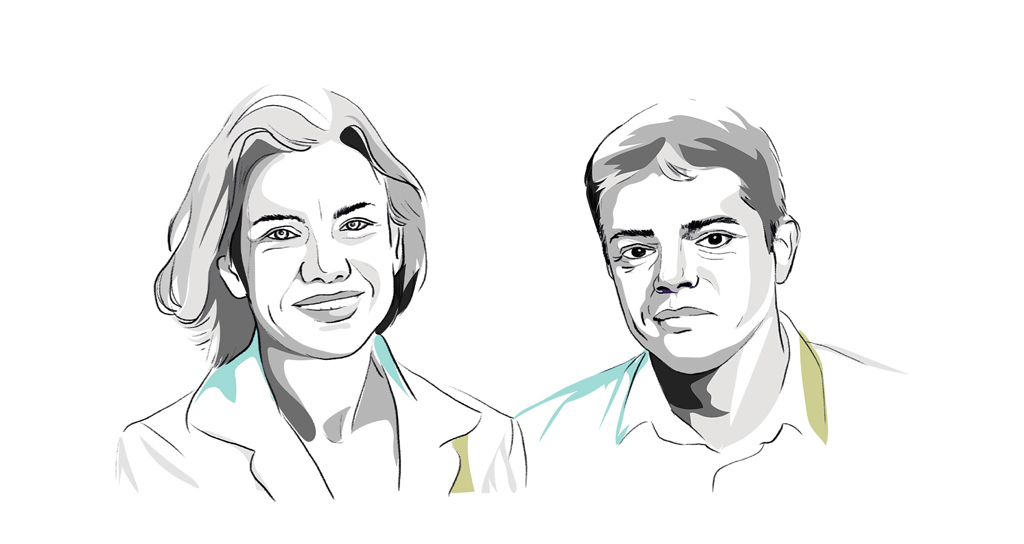Digital technologies and the revolution in uses are calling into question the principles that have so far governed workspace design and construction. The distinction between workspace and private space is increasingly blurred and the two are being replaced by environments that are simultaneously flexible and customised. Welcome to shared space! Why? How? To what extent? Eric Cassar, architect and founder of the Arkhenspaces firm, and Philippe Conus, Building Solutions Director at VINCI Energies, debate the issue.
Why is the issue of workspace sharing now such a focus of attention?
Eric Cassar. In our societies, space is a valuable asset for companies. The only way to use it more efficiently is to innovate and share it. In this respect, workspaces have a major advantage over residential spaces because it is much easier to experiment with them and transform them. Workspaces have changed far more over the past 100 years than residential spaces changed over several centuries.
Philippe Conus. The issue of shared workspaces is driven by two concomitant revolutions – the digital technology revolution, of course, but also the revolution in the uses to which technology is put, which is now erasing the barriers between types of space that have until now been separate, such as offices, houses, shops, and stations. These dual pressures are making it both necessary and possible to devise a different way to arrange space.
How does this impact facility management?
P.C. Until now, we began by providing technical maintenance for a building and then added a layer of services. Today, facility management cuts across three dimensions: the place, the person occupying it, and the technology. It is not that technical maintenance has become less important – far from it. It is and will increasingly be important going forward. But services are not confined to a place. They must be designed and rolled out based on an open space approach, particularly via applications that accompany a person as he or she moves around (how I get to my workspace, where I park, with whom I share a vehicle, when I leave, etc.).
What does it mean to share space?
E.C. The distinction between private space and the office is no longer operative. What was called the office has become the work environment and the work environment is deployed throughout space. Sharing space means broadening the range of possibilities, diversifying the nature of places and services, offering a person, in response to his or her request or situation, a quieter environment, a more private space or transport to a meeting, for example. In a nutshell, sharing space means customising solutions according to possibility, need and preference.
“Digital technology enables us to measure the use of space, adapt our response, and flexibly devise truly customised solutions.”
P.C. Sharing requires flexibility. Not so long ago, this was often considered a form of workplace dehumanisation – remember Accenture’s anonymous offices and file cabinets on casters. Today, digital technology enables us to measure the use of space, adapt our response, and flexibly devise truly customised solutions. Digital technology tells us how many people have access to the building, tracks their movement within it, identifies the services they use, and so on – either in real time or over the long term. All these data and trends serve as input for a range of services tailored to the uses and needs of both the workspace occupants and the building operation teams. We can, for example, adapt and even anticipate cleaning and maintenance schedules, modulate energy consumption curves, and offer specific concierge-type services.
Doesn’t all this raise privacy issues?
P.C. At La Factory, the VINCI Energies open innovation space in Paris-La Défense, we installed people-counting cameras with the consent of the employee representatives. The cameras provide only anonymous information. Prior user consent is a technology prerequisite as well, since the mobility application can only work for people who agree to be geo-located.
E.C. It is an issue, though. To me, the facility manager should serve as a countervailing power to the company. To make spaces smarter, the facility manager needs to have data concerning the people occupying the spaces. On the other hand, no one would agree to allow the data to be handed over to the employer. The facility manager must therefore make a commitment to serve as a trusted third party and agree not to transmit the data. It is similar to a situation in which I, as an architect, explain to a developer that I am working for him but also for the city. We must get agreement on a number of rules and then enforce them within a contractual framework.
How far can sharing be taken? Should it include customers, suppliers, people walking in off the street?
P.C. But it already does! L’Archipel, the future VINCI head office in Nanterre, will provide an auditorium and a sports facility open to the city. And its ground floor will be directly connected to the future RER Eole regional express line station.
With this fragmentation of workspaces, are we not running the risk of disrupting the identity of companies and the coherence of their image?
P.C. Arguably, the opposite is true. The rollout of workspaces should prompt employers to devote more effort to their head offices, to build emblematic buildings in their image that express values and meaning. This is already happening. Many companies are re-designing their head offices to reflect their identity.
“Offices all look alike. The controlled process must leave room to express difference, identity, and values.”
E.C. That is true, and it’s a good thing. But they don’t go far enough. You have to admit that offices all look alike. This is due to the prevailing economic approach. Builders have standard designs that have stood the test of time and that facilitate duplication. And investors buy buildings to rent and re-rent them. They shouldn’t be prevented from controlling the process this way. But they must leave room to express difference, identity, and values. When Apple, Amazon, and Facebook in the U.S. and companies like Bouygues and BETC in France design their headquarters, they are making a statement.
“One of the obstacles to the spread of the smart building, especially in France, is the fragmentation of the value chain.”
P.C. The fact remains that many of the groups you mention operate across the entire property value chain. They are simultaneously developers, builders, investors, operators, and tenants. One of the obstacles to the spread of the smart building, especially in France, is the fragmentation of the value chain. In most cases, the investor does not know the developer. The developer places an order with the builder for a structure that is as commercially viable – and therefore as neutral – as possible. The builder and the technology installer for their part do their best to keep costs down, even if this means making short-term choices. And the tenant wants first and foremost to reduce operating costs. If we want to accelerate the spread of the smart building, with its shared spaces and its customised services, we need to promote a more comprehensive approach that fosters cooperation among all the parties involved.
“We need to devise architecture that not only organises spaces but also coordinates them, in other words makes changes in space-time.”
E.C. The static vision is not necessarily the most effective vision. Today we need to devise architecture that not only organises spaces but also coordinates them, in other words makes changes in space-time. This can only be done if the operator and the architect work in close coordination from the very start of the design phase. The architect needs to propose new uses to the operator. The operator needs to agree to provide more information about how he intends the building to be used.
How can such cooperation between the various participants be encouraged, and how can the value chain be unified?
P.C. The first driver is probably economic. The digital revolution and the changing uses to which buildings are put are speeding up building obsolescence. A structure that cannot be digitalised and cannot provide a minimum range of services will lose market value. Developers will therefore, quite naturally, begin to take the new design and operation goals on board and undertake an increasing number of digital, service, and energy retrofits.
E.C. The important thing is to stop thinking in terms of “cost of construction” and to start reasoning in terms of the overall economic model. Digital technologies make it possible to invest the right effort in the right place at the right time. If a cost-benefit equation is drawn up, a digitalised building will ultimately cost less than a standard building.




